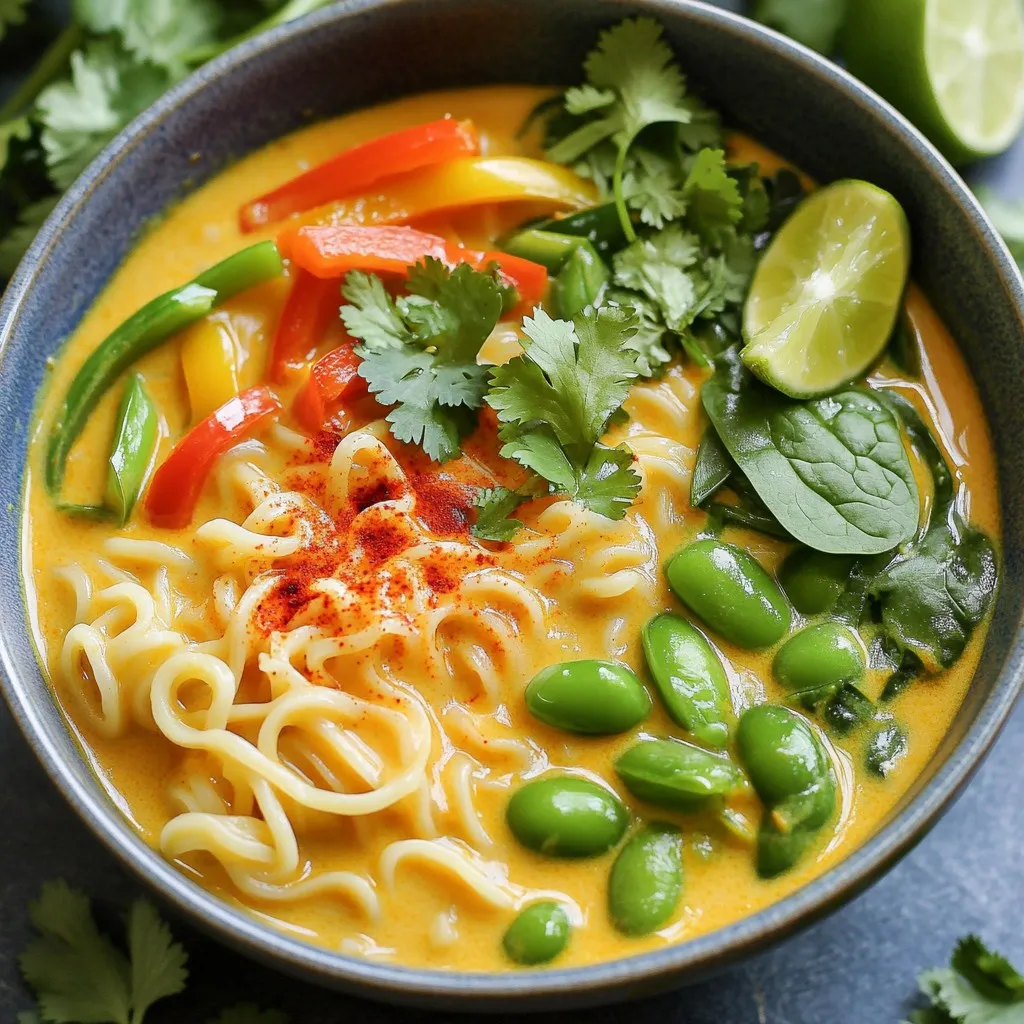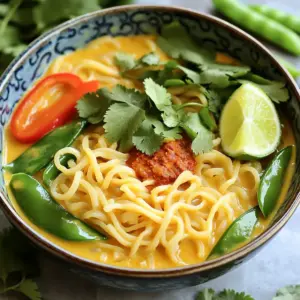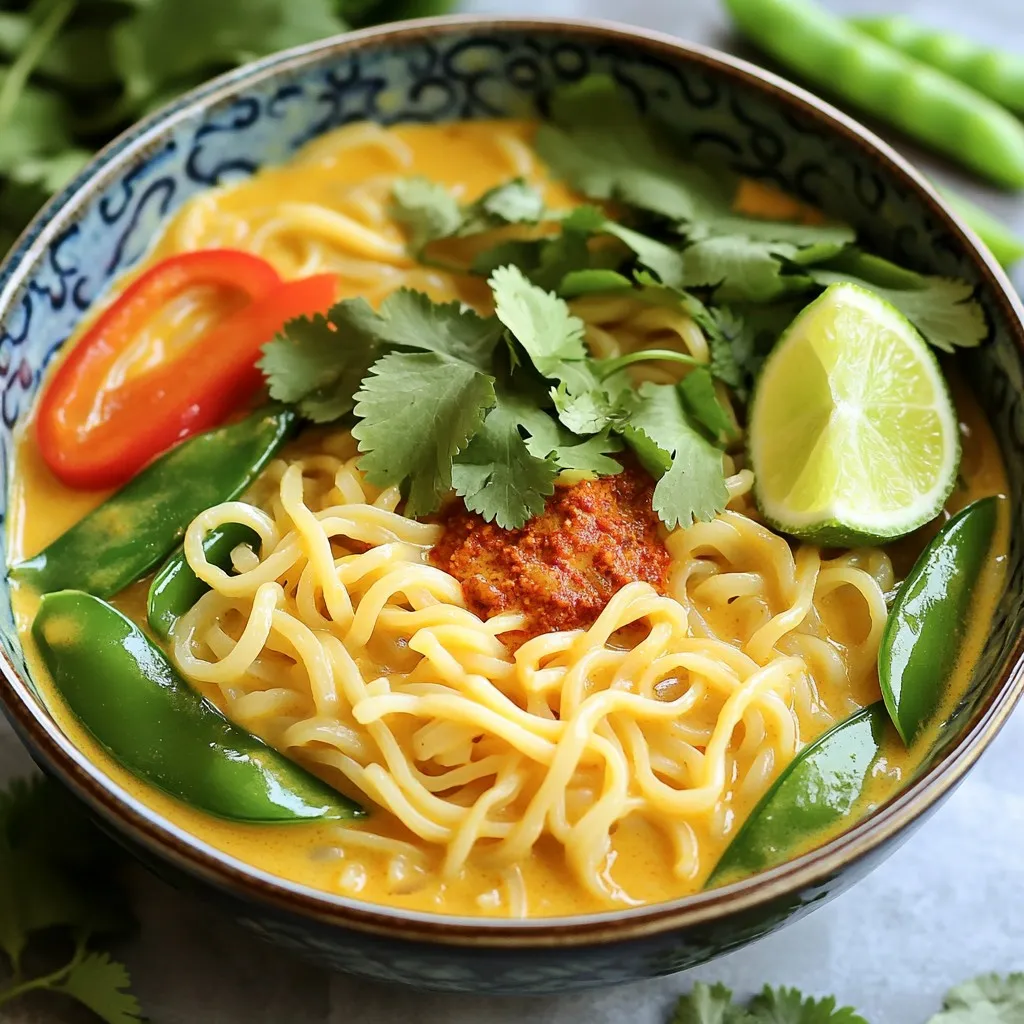Are you craving a simple and delicious meal? This One-Pot Thai Coconut Curry Noodles dish is your solution. It’s quick, easy, and packed with flavor! In this article, I’ll guide you through the ingredients, steps, and tips to make a weeknight dinner that everyone will love. Let’s dive into this tasty recipe and make your cooking stress-free and fun!
Ingredients
List of Essential Ingredients
For One-Pot Thai Coconut Curry Noodles, you need:
– 200g rice noodles
– 1 can (400ml) coconut milk
– 2 tablespoons red curry paste
– 1 tablespoon vegetable oil
– 1 cup vegetable broth (low-sodium preferred)
– 1 bell pepper, thinly sliced (choose red or yellow for color)
– 1 cup snap peas, trimmed
– 1 cup baby spinach, washed
– 1 tablespoon soy sauce (low-sodium for a healthier option)
– 1 tablespoon fresh lime juice
– Fresh cilantro, for garnish
– Lime wedges, for serving
– Salt and black pepper to taste
These ingredients come together to create a warm and tasty dish.
Suggested Ingredient Substitutions
You can swap some ingredients if needed. Here are a few ideas:
– Use any noodle type, like udon or egg noodles.
– Swap coconut milk with almond or soy milk for lighter options.
– Instead of red curry paste, use green curry for a different flavor.
– Add tofu or chicken for extra protein.
– Replace bell pepper with zucchini or carrots for a twist.
These changes keep the recipe flexible while still delicious.
Tips for Choosing Fresh Produce
When picking fresh produce, follow these tips:
– Look for vibrant colors in bell peppers and snap peas.
– Choose firm and crisp vegetables. They should feel heavy for their size.
– Check for blemishes or soft spots. Avoid any that look damaged.
– For spinach, choose bright green leaves without yellowing.
Fresh ingredients elevate the flavors in your dish, making it even better.
Step-by-Step Instructions
Preparation Steps
First, gather your ingredients. You need 200g rice noodles, 1 can of coconut milk, and 2 tablespoons of red curry paste. Also, prepare 1 tablespoon of vegetable oil, 1 cup of low-sodium vegetable broth, and 1 sliced bell pepper. Grab 1 cup of snap peas, 1 cup of baby spinach, and 1 tablespoon of soy sauce. Don’t forget 1 tablespoon of fresh lime juice, fresh cilantro for garnish, and lime wedges for serving. Make sure you have salt and black pepper ready for seasoning.
Cooking Method for One-Pot Meal
Start by heating the vegetable oil in a large pot over medium heat. Once the oil shimmers, add the red curry paste. Stir it in with a wooden spoon for about 1-2 minutes. This step helps release the spices’ aroma. Next, pour in the coconut milk and vegetable broth. Stir well to mix everything until smooth. Bring the pot to a gentle simmer. This is where the magic begins!
When your mixture simmers, add the rice noodles. Make sure they are fully submerged. Cook them for about 3-4 minutes. Stir occasionally to stop the noodles from sticking. After that, add in the sliced bell pepper, snap peas, and soy sauce. Keep cooking for another 3-4 minutes. Your goal is to have noodles that are al dente and veggies that are tender but still crisp.
How to Achieve Perfectly Cooked Noodles
To cook the noodles just right, watch them closely. You want them soft but not mushy. Stirring helps with even cooking and prevents sticking. Once they are nearly done, fold in the baby spinach. This adds color and nutrients. Let it wilt slightly. Finally, stir in the fresh lime juice and season with salt and black pepper to taste. After mixing, remove the pot from heat and let it rest for a minute. This lets the flavors blend beautifully.
Tips & Tricks
Expert Tips for Enhancing Flavor
To make your One-Pot Thai Coconut Curry Noodles shine, focus on fresh ingredients. Fresh lime juice adds brightness. You can adjust the amount based on your taste. Use low-sodium soy sauce to keep the dish light. For a touch of sweetness, consider adding a pinch of sugar. This helps balance the heat from the red curry paste.
You can also play with the spices. A little ginger or garlic can deepen the flavor. Sauté them with the red curry paste for the best results. If you want a bit more heat, add fresh chili slices. They can give your dish a nice kick.
Common Mistakes to Avoid
One common mistake is not cooking the noodles properly. Make sure they are fully submerged in the liquid. Stir them often to prevent sticking. Overcooking can lead to mushy noodles, so check them frequently.
Another mistake is using too much salt. The red curry paste and soy sauce are salty. Taste your dish before adding more salt. Lastly, don’t skip the fresh cilantro and lime at the end. They bring freshness that ties the dish together.
Serving Suggestions for Optimal Experience
Presentation is key for this dish. Serve the noodles in colorful bowls. Make sure to garnish with fresh cilantro. The green color pops and adds a fresh taste.
Always include lime wedges on the side. They let your guests add a squeeze for extra flavor. You can also serve this dish with a simple side salad. A crunchy salad can balance the creamy noodles. Enjoy this meal with friends or family for a fun weeknight dinner.

Variations
Alternative Proteins to Add
You can easily boost the protein in your One-Pot Thai Coconut Curry Noodles. Here are some great options:
– Chicken: Cut chicken breast into bite-sized pieces and add it to the pot after the red curry paste. Let it cook until no longer pink.
– Shrimp: Add peeled shrimp during the last few minutes of cooking. They cook fast and add a lovely taste.
– Tofu: Use firm tofu, cut into cubes. Sauté it with the curry paste for extra flavor before adding liquids.
Adding these proteins makes the dish heartier and more filling.
Vegetarian and Vegan Adaptations
This recipe is quite easy to adapt for vegetarians and vegans.
– Veggie Broth: Use vegetable broth instead of chicken broth to keep it plant-based.
– Coconut Milk: This recipe already uses coconut milk, a perfect creamy base.
– Tofu or Tempeh: Substitute tofu or tempeh for meat. They soak up flavors well and provide nice texture.
These changes keep the dish tasty and satisfying for everyone.
Gluten-Free Substitutes for Noodles
If you need a gluten-free option, don’t worry! Here are some substitutes:
– Rice Noodles: The recipe already calls for rice noodles, which are naturally gluten-free.
– Zucchini Noodles: Spiralize zucchini for a fun, low-carb option. Add them towards the end of cooking to keep them crisp.
– Shirataki Noodles: These are made from the konjac plant and are also gluten-free. Rinse them well before adding to the pot.
These substitutes let you enjoy the dish without gluten. Each option brings a unique flavor and texture!
Storage Info
Best Practices for Storing Leftovers
To keep your One-Pot Thai Coconut Curry Noodles fresh, let them cool first. Then, place them in an airtight container. Store them in the fridge for up to three days. This keeps the flavors intact and prevents spoilage. If you notice any excess liquid, that’s normal. Just give it a stir before eating.
Reheating Instructions
When you want to enjoy your leftovers, reheat them gently. You can use a microwave or a pot on the stove. If using a microwave, place the noodles in a bowl and cover it. Heat for one to two minutes, stirring halfway. For the stove, add a splash of water and heat on low. Stir until warm. This keeps the noodles from drying out.
Freezing Tips for Long-Term Storage
If you want to store your noodles for longer, freezing is a great option. Allow the dish to cool completely. Then, transfer it to a freezer-safe container. Leave some space at the top for expansion. You can freeze them for up to three months. When ready to eat, thaw in the fridge overnight. Reheat as mentioned earlier. Enjoy your Thai coconut curry noodles whenever you like!
FAQs
How Spicy is One-Pot Thai Coconut Curry Noodles?
One-Pot Thai Coconut Curry Noodles have a mild to medium spice level. The red curry paste gives it warmth, but the coconut milk cools it down. If you like heat, add more red curry paste or some chili flakes. For a milder dish, use less curry paste. This way, you can adjust the spice to your taste.
Can I Use Different Types of Noodles?
Yes, you can use other noodles! Rice noodles work best for this dish, but you can try egg noodles or even whole wheat noodles. Just remember to adjust cooking times based on the type of noodles you choose. Always check the package for specific instructions to ensure the best results.
What Can I Serve with This Dish?
You can serve One-Pot Thai Coconut Curry Noodles with many sides. A fresh salad pairs well, adding crunch and color. You might also enjoy spring rolls or crispy vegetable tempura for extra texture. If you want protein, grilled chicken or shrimp complements the flavors nicely. Don’t forget lime wedges for a zesty kick!
This blog post covered all you need for One-Pot Thai Coconut Curry Noodles. We discussed the key ingredients, including substitutions and tips for fresh produce. You learned a step-by-step method for preparation and cooking, plus expert tips to boost flavor. We explored variations like adding proteins or making it vegan. Lastly, we shared storage tips for leftovers and answered common questions. Remember, cooking should be fun and easy. Enjoy creating this dish and make it your own!


